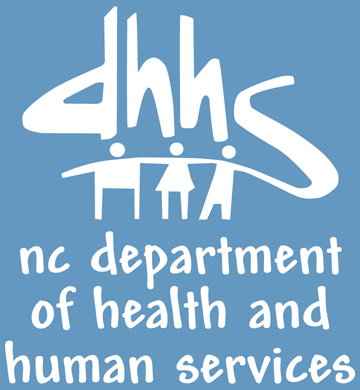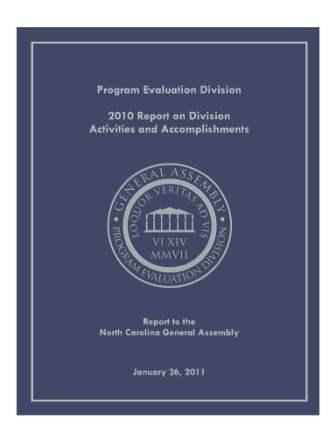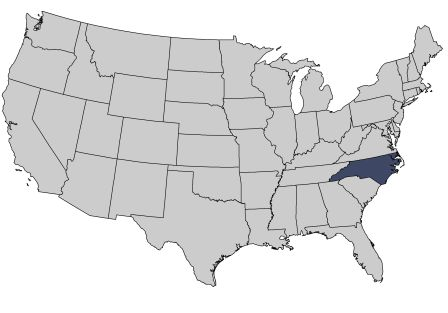
| Allotment-Specific and System-Level Issues Adversely Affect North Carolina’s Distribution of K-12 Resources (November 2016) 2016-11
North Carolina distributes state funds for the operation of K-12 public schools through a system consisting of 37 different allotments, each of which reflects a component of the education delivery model. For example, there are separate allotments for classroom teachers, textbooks, administration, and transportation. In Fiscal Year 2014–15 the Department of Public Instruction (DPI) distributed $8.4 billion in state funds to Local Education Agencies (LEAs) and charter schools through the allotment system. The Program Evaluation Division found issues with individual allotments or issues that span numerous allotments, ranging from unintended consequences of particular methods and formulaic policies and procedures to a lack of rationale for the factors used to determine how resources are distributed. The Division also identified deficiencies with the allotment system as a whole resulting from overall system complexity and lapses in the control environment. Based on these findings, the General Assembly should either overhaul the system for how resources are distributed by transitioning to a weighted student funding model that uses individual students as the building blocks for developing a state’s education budget, or reform the current system by addressing individual allotment deficiencies and providing direction to improve transparency and accountability. |
Final Report (UPDATED NOVEMBER 23, 2016)
Report Digest
Executive Summary
Recommendations
Presentation
Handouts
|

| Medicaid Program Integrity Section is Not Cost-Effectively Identifying and Preventing
Fraud, Waste, and Abuse (November 2016) 2016-05
The Program Integrity (PI) Section of North Carolina’s Medicaid program is charged with detecting and preventing fraud, waste, and program abuse, and ensuring that taxpayer dollars are used appropriately. The Program Evaluation Division found that due in part to a lack of access to valid and reliable claim payment data, the number of fraud referrals made by the PI Section has declined in recent years. Additionally, the lack of a formal risk assessment process and performance management information has limited the Section’s cost-effectiveness. Finally, the PI Section is neither effectively monitoring Medicaid recipient eligibility determinations nor effectively utilizing available information gleaned from reviews of eligibility determinations and medical service claims. The General Assembly should amend state law to adopt a uniform methodology to measure the severity of errors; provide incentives for county social services departments to ensure accuracy of eligibility determinations; require the identification of alternatives to increase amounts recouped from overpayments and percentage of fraud referrals accepted; develop a corrective action process for providers selected for enhanced oversight; and produce an annual performance report and work plan. |
Final Report
Executive Summary
Recommendations
Presentation
|

| Funding for North Carolina’s Community Colleges: A Description of the Current Formula and Potential Methods to Improve Efficiency and Effectiveness (October 2016) 2016-09
The majority of state funding for North Carolina’s 58 community colleges is distributed via a funding formula based on enrollment. North Carolina’s formula is more sophisticated than those used in some other states because it uses a tier system to account for differences in programs and levels of study. The Program Evaluation Division found that the funding formula is functional and generally acceptable to institutions and the State Board, though college presidents expressed concerns about the amount of funding in general. If the General Assembly wishes to change the current funding formula to improve efficiency and effectiveness, it could consider initiatives to increase the equitable distribution of institutional and academic support funds; improve funding stability through the use of a stop-loss provision and by funding the Enrollment Growth Reserve; align tier funding with course costs; refine the existing performance-based funding system; and add needs-based funding to the enrollment portion of the formula. |
Final Report
Presentation
|

| PED’s Review of the North Carolina Guaranteed
Admissions Program (NCGAP) Report (April 2016) 2016-05
Session Law 2015-241 established NCGAP, a deferred admissions program for postsecondary students identified as academically at risk. In January 2016, JLPEOC directed PED to assess the methodology and accuracy of conclusions presented in a legislatively mandated report submitted by the UNC Board of Governors and the State Board of Community Colleges on potential program impacts of NCGAP. PED’s review of the NCGAP report found several shortcomings and concluded it may understate community college cohort six-year graduation rates; used flawed measures of intent to attend a university in its sample selection process; excluded important variables in its regression model; failed to consider recent efforts to increase the success of transfer students; understated potential savings to students; may not adequately measure all student debt; estimated decreases in enrollment at UNC institutions without recognizing simultaneous increases in community college enrollment and degree production; and failed to support its estimate of “tens of millions of dollars” being necessary to advise NCGAP-participating students. |
Final Report
Presentation
|

| Timeliness of Medicaid Eligibility Determinations Declined Due to Challenges Imposed by NC FAST and Affordable Care Act Implementation (April 2016) 2016-04
In North Carolina, county departments of social services (county DSS offices) perform Medicaid eligibility determinations under the supervision of the Department of Health and Human Services (DHHS). County DSS offices failed to meet North Carolina’s timeliness standard for processing Medicaid applications in Fiscal Years 2013–14 and 2014–15. The decrease in timeliness during these years coincided with a workload increase for county DSS offices stemming from conditions created by NC FAST implementation and enactment of the Affordable Care Act. NC FAST offers DHHS the opportunity to proactively manage and monitor county DSS offices, yet the department needs additional resources and authority to hold counties accountable. The General Assembly should authorize DHHS to intervene and take over county administration of Medicaid eligibility determinations when warranted; direct DHHS to report on the timeliness of determinations for Fiscal Years 2015–16 and 2016–17; and appropriate $300,000 to DHHS to support utilization of NC FAST data for performance measurement and evaluation. |
Final Report
Executive Summary
Presentation
Handout
|

| Opportunities Exist to Increase the Accountability and Independence of the Board of Review (March 2016) 2016-03
Session Law 2015-238 directed PED to study the value of the Board of Review, the entity that hears higher authority appeals of unemployment benefit determinations. PED found that elimination of the higher authority appeals function or the Board would not result in any General Fund savings and that both the function and the entity provide benefits. However, the Board is dependent on Division of Employment Security (DES) staff, lacks policies and procedures, and does not track necessary data. The General Assembly should transfer staff from DES to the Board; direct the Board to develop policies and procedures; and direct DES to work with the Board to track and collect necessary data. |
Final Report
Executive Summary
Presentation
|

| Enhanced Oversight of Service Contracts Can Help Ensure Cost-Effective Performance (January 2016) 2016-01
State agencies are responsible for each of three phases of contract procurement: sourcing evaluation, contract formation, and contract management. PED found that state agencies are not ensuring procurement of contracted services achieves best value. PED examined 133 contracts for high-value services with total award value of $1.24 billion and found $511 million stemmed from non-competitive practices. State agencies are not adequately adhering to best practices with regards to documenting the basis for their decisions to contract with private providers; not including all necessary attributes of an effective service contract during the procurement process; and not ensuring compliance with terms and conditions. State-level monitoring by the Department of Administration’s Division of Purchase and Contract (P&C) has also failed to contribute to achievement of best value. The General Assembly should require state agencies to submit business cases for high-value services to P&C for review and approval in accordance with established criteria and direct P&C to implement a system to monitor state agency-administered contracted services. |
Final Report
Executive Summary
Presentation
|

| North Carolina Should Discontinue the Economic Development Tiers System and Reexamine Strategies to Assist Communities with Chronic Economic Distress (December 2015) 2015-11
The economic development tiers system ranks North Carolina counties according to an index of economic measures and low-population/high-poverty adjustments. The Department of Commerce assigns each county a designation of Tier 1, Tier 2, or Tier 3, with Tier 1 counties being the most economically distressed. The system was created to distribute business tax incentives, but that program expired in 2014, and currently the only incentives awarded through its use are discretionary grants. Fifteen state programs use the tiers system to distribute resources but these programs are not directing more resources to the most economically distressed areas. The system has been altered incrementally during the past 30 years but components of its formula still distort identification of economic distress. The General Assembly should discontinue the economic development tiers system for all non-economic development programs by July 1, 2017; sunset the system for all economic development programs as of July 1, 2018; and form a legislative commission to reexamine the State’s strategy for identifying and assisting economically distressed communities. |
Final Report
Executive Summary
Presentation
Handout
|

| North Carolina Should Centralize Management of State Employee Supplemental Insurance Benefits (August 2015) 2015-07
North Carolina’s Retiree Health Benefit Fund contributes the State’s share of retiree premiums to the State Health Plan. Unfunded liability for the fund is $25.5 billion, and North Carolina is not a strong performer on measures used to compare the funded status of states. Several options to reduce the unfunded liability exist: increasing appropriations, shifting costs to the federal government, transitioning to a defined contribution model, reducing the number of individuals eligible, requiring contributions from active employees, and increasing the amount retirees pay for the benefit. To address the unfunded liability, the General Assembly should direct the State Health Plan to shift costs to the federal government by requiring eligible retirees to be on Medicare Advantage plans, generating an estimated savings of up to $64 million annually, and could appoint a joint committee to determine which other options to pursue in light of financial and legal considerations. |
Executive Summary
Final Report
|

| Unfunded Actuarial Liability for Retiree Health is Large, but State Could Save Up to $64 Million Annually by Shifting Costs to Medicare Advantage Plans (July 2015) 2015-05
North Carolina’s Retiree Health Benefit Fund contributes the State’s share of retiree premiums to the State Health Plan. Unfunded liability for the fund is $25.5 billion, and North Carolina is not a strong performer on measures used to compare the funded status of states. Several options to reduce the unfunded liability exist: increasing appropriations, shifting costs to the federal government, transitioning to a defined contribution model, reducing the number of individuals eligible, requiring contributions from active employees, and increasing the amount retirees pay for the benefit. To address the unfunded liability, the General Assembly should direct the State Health Plan to shift costs to the federal government by requiring eligible retirees to be on Medicare Advantage plans, generating an estimated savings of up to $64 million annually, and could appoint a joint committee to determine which other options to pursue in light of financial and legal considerations. |
Executive Summary
Final Report
Presentation
|

| North Carolina Should Dispose of Unneeded Real Property and Improve Portfolio Management to Reduce Costs (June 2015) 2015-04
North Carolina’s Department of Administration (DOA) is responsible for managing the State’s portfolio of real property, consisting of nearly $28 billion in state-owned buildings and land and $65 million in annual expenditures for leased space. From a sample of 49 state-owned and leased properties, the Program Evaluation Division identified unneeded properties that could generate an estimated $14.3 million in one-time revenue and provide $2.6 million in future cost avoidance. PED found the State lacks a systematic process and data to identify unused and underutilized real property, and found DOA has not implemented portfolio management practices. The General Assembly should direct DOA to actively manage the State’s portfolio of real property; improve the completeness, accuracy, and security of the State’s inventory of real property; dispose of the unneeded properties identified in this report; and determine if suitable state-owned space can meet lease requests. The General Assembly should also modify state law to require state agencies to collect, track, and report data on state-owned and leased space and maintain a current facilities management plan. |
Executive Summary
Final Report
Presentation
Handouts
|

| North Carolina Should Eliminate the Use of Personal Services Contracts in Favor of Using Existing Mechanisms (February 2015) 2015-03
In order to ensure open competition and transparency, the procurement of goods and services by North Carolina state agencies and institutions is subject to numerous laws, rules, and regulations. The Program Evaluation Division found that agencies and institutions have circumvented state law when procuring personal services and have also compensated contractors at high rates. In addition, Executive Branch agencies have violated state law by not obtaining approval for IT personal services contracts, and the Office of Information Technology Services (OITS) lacks a process to ensure compliance. Personal services contracts are unnecessary because mechanisms with greater oversight already exist. The General Assembly should enact legislation prohibiting the use of personal services contracts; requiring Executive Branch agencies to use these existing mechanisms; and requiring OITS and the Office of State Budget and Management (OSBM) to approve the procurement of IT services from individuals, report on a biennial basis, and conduct compliance reviews. |
Executive Summary
Final Report
Presentation
Recommendations
|

| Implications of Funding Alcohol and Substance Abuse Treatment or Prevention with Alcohol Tax Earmark (February 2015) 2015-02
The impetus for this study was a request from the Alcoholic Beverage Control(ABC) Commission to the General Assembly to redirect the $1.4 million alcohol tax earmark from the Department of Health and Human Services (DHHS) and substance abuse treatment services to the ABC Commission's underage drinking prevention initiative. During the course of this project, the ABC Commission approved an increase in the bailment surcharge, a fee that funds the Commission's operations, to pay for the underage drinking prevention program, and therefore no longer needs the DHHS earmark. This report first details how DHHS uses the $1.4 million alcohol tax earmark and the potential consequences of redirecting the funding to the ABC Commission. Next, the report describes the ABC Commission's past and present efforts to create and fund an underage drinking program, called Talk It Out. Finally, this report presents actions that the General Assembly could take to ensure the Talk It Out program is successful. |
Executive Summary
Final Report
Presentation
|

| Licensing Processing Fees Are Inequitable; Permit DOI Vendor to Charge Different Processing Fees Based on Effort and Cost (January 2015) 2015-01
The Department of Insurance's (DOI's) Agent Services Division (ASD) issues licenses to the insurance industry, the bail bond industry, and non-insurance business entities. DOI entered into a contract with Pearson VUE in December 2011 to provide administrative services for all license types regulated by the department. The Program Evaluation Division found that Pearson VUE's licensing processing fees are disproportionate to the relative cost of processing the different types of license applications. PED also found that DOI has improved licensure services through outsourcing, and that ASD continues to work with Pearson VUE to address licensee concerns. The General Assembly should direct ASD to issue a request for proposal for licensing administrative services that allows the contractor to charge different processing fees based on the cost and effort necessary to process licenses for the different industries. |
Executive Summary
Final Report
Presentation
Handouts
|

| Occupational Licensing Agencies Should Not be Centralized, but Stronger Oversight is Needed (December 2014) 2014-15
Occupational licensing agencies (OLAs) are state agencies that regulate the licensure of persons within a particular profession or occupation but that receive no state general revenue and are not subject to legislatively mandated spending restrictions. PED found that transferring regulatory authority or administrative responsibilities from OLAs to a central state agency may not result in improved performance and would likely entail significant implementation costs. PED also determined that there is insufficient state-level oversight to ensure OLAs are efficiently and effectively protecting the public. The General Assembly should establish an Occupational Licensing Commission to assist the General Assembly and OLAs in improving effectiveness and resolving disputes; ensure that the OLAs required to comply with reporting requirements are clearly defined and listed; ensure the complaint process used by OLAs includes specified capabilities and attributes; and assign a legislative committee to evaluate the continuing need for licensing authority for 12 identified OLAs. |
Executive Summary
Final Report
Presentation
Handout
|

| DHHS Should Integrate State Substance Abuse Treatment Facilities into the Community-Based System and Improve Performance Management (November 2014) 2014-14
North Carolina's public system for adult substance abuse treatment has two primary components—the community-based system of Local Management Entities/Managed Care Organizations (LME/MCOs) and the three state-operated Alcohol and Drug Abuse Treatment Centers (ADATCs). Separation of the ADATCs from the community-based system creates operational silos which impose challenges to utilization management and continuity of care and limits the State's ability to address service gaps and manage cost. North Carolina also lacks an adequate performance management system that tracks long-term outcomes of public substance abuse treatment. The General Assembly should require the Department of Health and Human Services to integrate the ADATCs into the community-based system by transitioning funding to LME/MCOs and requiring LME/MCOs to pay for services at the ADATCs. The General Assembly should also direct the Division of Mental Health, Developmental Disabilities, and Substance Abuse Services to strengthen its performance management by tracking long-term outcomes of treatment. |
Executive Summary
Final Report
Presentation
Handouts
|

| Overnight Respite Pilot at Adult Day Care Facilities Perceived as Favorable, but Lacked Objective Measures of Success (October 2014) 2014-11
Session Law 2011-104 authorized the Department of Health and Human Services to pilot an overnight respite program in four facilities that provide adult day care and directed the Program Evaluation Division to evaluate its success. Stakeholders perceive the pilot as successful, but only one of the facilities consistently provided overnight respite. PED found the legislative mandate for the pilot and its implementation by DHHS only met two of ten recommended components of a well-designed pilot program. In addition, the legislative prohibition against using state or Medicaid funding for the pilot hindered its effectiveness. Furthermore, no organization affiliated with respite care maintains data on the need for the service. The General Assembly should allow the pilot program authorizing overnight respite at adult day care facilities to expire on June 1, 2015, and require state agencies and institutions initiating pilot projects to adhere to standards established by UNC's School of Government. |
Executive Summary
Final Report
Presentation
|

| North Carolina Needs a Coordinated Strategy to Guide the Changing Landscape of Veterans Programs (September 2014) 2014-10
In State Fiscal Year 2013–14, North Carolina state agencies and public higher education institutions operated 23 programs for veterans, 11 of which spent $53.9 million solely on veterans and their families. However, few of these programs track outcome data, and therefore the State cannot determine the extent to which they improve the lives of their intended beneficiaries. Although the Governor recently created a Working Group on veterans via executive order, North Carolina lacks a coordinated and comprehensive effort to support veterans in the State. The General Assembly should establish the Task Force on Veterans, Service Members and their Families in statute, direct this group to develop and implement a statewide strategic plan to track and improve services for veterans and their families, direct state entities to track and report information to the Task Force, and create a legislative oversight committee to monitor and oversee the implementation of this plan. |
Executive Summary
Final Report
Presentation
Handouts
|

| Revising State Child Support Incentive System Could Promote Improved Performance of County Programs (July 2014) 2014-08
North Carolina's child support program operates under a state-supervised, county-administered model. Based on federal performance measures, the program ranks only 24th among the 50 states. The Child Support Services State Office does not effectively use its federal incentive award to promote improved county program performance. Additionally, the CSS State Office has not established specific spending guidelines and does not track incentive payment expenditures. The General Assembly should direct the CSS State Office to retain 25% of federal incentive money to improve centralized services and provide employee incentive bonuses, and should direct counties to report how incentive payments are being reinvested and to maintain their level of expenditures. |
Executive Summary
Final Report
Presentation
Handouts
|

| Improved Oversight of Volunteer Fire Department Fund and
Volunteer Rescue/EMS Fund Needed; $8 Million Surplus Found (April 2014) 2014-06
The Volunteer Fire Department Fund and Volunteer Rescue/EMS Fund provide matching grants for fire and rescue departments to purchase equipment and make capital improvements. The Department of Insurance's (DOI's) failure to compare actual to projected receipts for both grant programs has resulted in an $8 million surplus in the Volunteer Fire Department Fund. Additionally, DOI's oversight of the grant award and distribution process could be improved. The General Assembly should determine how to apply the surplus in the Volunteer Fire Department Fund and direct DOI to improve its oversight of both grant programs. |
Executive Summary
Final Report
Presentation
|

| North Carolina Needs to Strengthen Its System for Monitoring and Preventing the Abuse of Prescribed Controlled Substances (April 2014) 2014-05
In North Carolina, there are four mechanisms to monitor and prevent the abuse of prescribed controlled substances: oversight of prescribers and dispensers, the Controlled Substances Reporting System (CSRS), Medicaid lock-in, and law enforcement. Currently, prescribing guidelines and continuing education requirements for prescribers are insufficient. The CSRS is underutilized and lacks important features for security and data analysis. Meanwhile, the lock-in program has been non-operational since July 2013, costing the Medicaid program an estimated $1.3 million to $2 million. The General Assembly should direct the development and adoption of statewide prescribing guidelines and require continuing education, and should also direct the Department of Health and Human Services to modify the contract for the CSRS to improve performance, improve the effectiveness of the Medicaid lock-in program, and develop a strategic plan and performance management system. |
Executive Summary
Final Report
Presentation
Handouts
|

| Improved Administrative Program Monitoring by the Department
of Public Instruction Can Save Over $19 Million Annually (April 2014) 2014-04
In Fiscal Year 2012–13, the State spent $12 billion to provide a system of free public education. To ensure these funds are effectively used, the Department of Public Instruction provides administrative services that indirectly support the achievement of student outcomes. The cost to provide these services could be reduced by $19.3 million annually by changing the formula to allocate funds for school bus operations and by reducing textbook warehouse staffing. An additional $6.1 million of non-recurring savings could be realized by reducing the statewide fleet of spare school buses and the inventory of replacement parts. Currently, DPI's performance management system does not ensure the effectiveness of its administrative support programs. The General Assembly should direct DPI to take specific actions to improve administrative efficiency and require the department to implement an effective performance management system. |
Executive Summary
Final Report
Presentation
|

| Department of State Treasurer Should Strengthen Its Oversight of the Firefighters' and Rescue Squad Workers' Pension Fund (March 2014) 2014-03
The Firefighters' and Rescue Squad Workers' Pension Fund provides $170 per month in retirement benefits. The Pension Fund is adequately funded, but the State's annual required contribution now exceeds the amount of property insurance premium tax proceeds going to the General Fund. The Department of State Treasurer overstated appropriation requests due to overly conservative actuarial assumptions; accepted delinquent member contributions without collecting additional costs to compensate for lost investment earnings; and minimally enforced the prohibition against paying benefits to members still working as firefighters or rescue workers. The department is taking steps to address these issues, and the General Assembly should require annual reports on its progress. |
Executive Summary
Final Report
Presentation |

| Performance Measurement and Monitoring Would Strengthen Accountability of North Carolina's Driver Education Program (March 2014) 2014-02
In response to a 2010 review by the Program Evaluation Division, the General Assembly passed reforms in 2011 that reaffirmed the responsibility of the Department of Public Instruction to administer the driver education program. While generally responsive to the 2011 reform law, DPI's strategic plan lacks objectives and quantitative performance indicators. In addition, DPI does not have a uniform method to deliver driver education statewide, performs no monitoring of LEA instructors, and failed to conduct a valid pilot project for testing the effectiveness of online versus traditional instruction. The General Assembly should require statewide performance measures and a data-driven outcome monitoring system for driver education as well as a feasibility study on offering uniform online classroom driver education. |
Executive Summary
Final Report
Presentation
Handout |

| Revenue and Cost Trends Indicate Deficit in Volunteer Safety Workers' Compensation Fund in FY 2020–21 (February 2014) 2014-01
The Volunteer Safety Workers' Compensation Fund provides workers' compensation benefits to emergency first responders for compensable injuries or deaths. Without an increase in the revenue base, annual Fund expenditures will exceed total assets beginning in Fiscal Year 2020–21. To help maintain the long-term health of the Fund, the General Assembly should direct the State Fire and Rescue Commission to increase annual member premium income, modify the Department of Insurance's actuarial responsibilities with regard to the Fund, require the commission to enhance the Fund's cost-containment efforts by using a more data-driven approach, and amend statute to clarify Fund eligibility conditions. |
Executive Summary
Final Report
Presentation |

| The UNC System Needs a More Comprehensive Approach and Metrics for Operational Efficiency (December 2013) 2013-08
The University of North Carolina (UNC) is a public, multi-campus university with 16 higher education institutions that differ in size, complexity, and scope. Since 2006, the UNC system has engaged in 11 operational efficiency projects that have saved $101.2 million to date. Despite these savings, the UNC system lacks important characteristics of a comprehensive approach to operational efficiency. The system also does not use specific metrics that measure the operational efficiency of its constituent institutions and lacks a reliable funding source for these efforts. In addition, most campuses do not track savings from operational efficiency efforts. The General Assembly should direct the UNC system to develop a more comprehensive approach to operational efficiency, including adopting a board policy stating its commitment and goals for these efforts, adopting metrics to track operational performance, and improving chancellor accountability. |
Executive Summary
Final Report
Presentation
Handouts |

| Local Boards and Associations Administer Firefighters' and Rescue Squad Workers' Relief Funds with Limited State Oversight (November 2013) 2013-06
The Firefighters' Relief Fund, which has a state and local component, and the Rescue Squad Workers' Relief Fund provide benefits to firefighters and rescue personnel. Relief fund money is not being spent by local boards and non-profit associations at the rate intended by the General Assembly, has been spent on non-permitted uses, and is being invested without regulation. The General Assembly should either consolidate the State and local firefighters' relief funds and make administration of that consolidated fund along with the Rescue Squad Workers' Relief Fund the responsibility of the Department of Insurance, or improve oversight of all relief funds under their current administrative structures. |
Executive Summary
Final Report
Presentation |

| Overview of School Choice Options Provided by Colorado's Douglas County School District (October 2013) 2013-05
The Joint Legislative Program Evaluation Oversight Committee directed the Program Evaluation Division to examine Colorado's Douglas County School District to determine whether its approach to school choice can inform state education policy-making in North Carolina. PED identified strategies that DCSD has taken to improve school choice in Douglas County, including expanding home education enrichment services, developing the Choice Scholarship Program, and enhancing partnerships with locally authorized charter schools. The General Assembly should consider several factors in determining whether to implement aspects of the DCSD approach to school choice, including: limited student performance data, demographic differences, and statutory changes that would be necessary for implementation. A statewide community engagement and strategic planning process could assist in determining whether the Douglas County approach provides opportunities for improving and expanding school choice options in North Carolina. |
Executive Summary
Final Report
Presentation
Handout
National Availability of School Choice Options |

| Centralized Fleet Operations Will Improve Management and Oversight of Department of Public Safety Vehicles (April 2013) 2013-04
The General Assembly directed the Program Evaluation Division to evaluate fleet management among major law enforcement agencies. This report focuses on the 2,398 law enforcement vehicles owned and operated by the Department of Public Safety (DPS). The management and oversight of law enforcement vehicles in DPS is fragmented, decentralized, and does not meet best practices. Furthermore, despite a directive to consolidate, DPS has yet to formalize a plan for centralized fleet management operations. The General Assembly should direct DPS to develop a plan and proposal for the implementation of a centralized fleet management program that meets best practice standards. |
Executive Summary
Final Report
Presentation
Handout |
 |
Options for Creating a Separate Department of Medicaid Require Transition Planning (March 2013) 2013-03
The Department of Health and Human Services (DHHS) is the single state agency responsible for the Medicaid Program and must operate within federal guidelines. DHHS has broad flexibility to manage the Medicaid Program and has delegated Medicaid administrative functions to the Division of Medical Assistance, other DHHS divisions and offices, other state agencies, and local government agencies. Based on experiences in other states, options exist for changing the organizational structure of the North Carolina Medicaid Program including a Department of Medicaid, a Medicaid Program Authority, and a Department of Health Services. Creating a new Medicaid agency in North Carolina has implications for the Medicaid Program, DHHS, and statewide business functions and would require a 12 to 18 month transition period.
|
Executive Summary
Final Report
Presentation
Handout |

| North Carolina Does Not Track Lands Submerged Under Navigable Rivers or Know the Extent of Private Claims (January 2013) 2013-02
The Department of Administration (DOA) is charged with managing and controlling the State's submerged lands. DOA does not have a comprehensive inventory of lands submerged under navigable rivers, so the extent to which private parties may hold title to these lands is unknown. Whereas DOA grants and tracks certain types of easements, it does not require easements for many structures built on lands submerged under navigable rivers and does not exercise its authority to lease or convey mineral deposits for most mining on submerged lands. The General Assembly could consider requiring DOA to improve its management and tracking of submerged lands and creating a submerged lands claims process based on a process North Carolina used for 25 coastal counties in the past. |
Executive Summary
Final Report
Presentation |
 |
The Division of Public Health Should Remain in the Department of Health and Human Services. (January 2013) 2013-01
North Carolina's public health system is an intricate network of partnerships between the Division of Public Health and local health departments, state agencies and universities, and other entities. North Carolina's public health system is seen as a model, but the State ranks in the bottom half of states for health outcomes because of high risk factors. The General Assembly should establish the North Carolina Public Health Council to develop a government-wide action plan and direct the Division of Public Health to explore ways to increase regionalization, improve the use the data, and strengthen quality improvement activities.
|
Executive Summary
Final Report
Presentation
Handout |
 |
Division Activities and Accomplishments: 2008 - 2012
(January 2013)
The Program Evaluation Division includes recommendations in our reports for increasing the efficiency and effectiveness of North Carolina government. This publication follows up on those recommendations to determine what actions have been taken by the General Assembly or the agencies that were the subject of our evaluations. This publication also includes information about the program evaluation process and legislative oversight organization in North Carolina and across the country. |
2008-2012 Report
|
 |
How North Carolina Compares
(January 2013)
This compendium ranks North Carolina relative to other states on areas including population, health, education, taxes, and expenditures. This publication was designed as a quick reference that allows state comparisons across indicators and may be useful when evaluating outcomes of state government programs. Data were extracted from the U.S. Census Bureau and other national databanks to assure uniformity of measurement across states. |
2013 Report
2013 Dashboard
2011 Report
2009 Report
Presentation
|

| Options for the Indian Cultural Center Will Allow the Site to Meet its Cultural, Recreational, and Economic Development Intent (December 2012) 2012-13
The North Carolina Indian Cultural Center has not become what was once envisioned. The site's geography, condition, and size have constrained development, and the current lease structure is problematic. As separate parcels, the site can still serve its initial intent. However, the need to preserve and promote North Carolina American Indian culture remains. The General Assembly should direct the Department of Administration to terminate the leases and dispose of and allocate the four parcels comprising the site, and direct the Commission of Indian Affairs to develop strategic plan for the promotion and preservation of North Carolina American Indian culture. |
Executive Summary
Final Report
Presentation
Handout |
 |
Stronger Reporting and Management Structure Would Improve State Bureau of Investigation Vehicle Oversight (November 2012)
2012-12
The General Assembly directed the Program Evaluation Division to evaluate fleet management among major law enforcement agencies. This report focuses on the 384 vehicles operated by the Department of Justice's State Bureau of Investigation. Although the bureau implemented policies and procedures related to vehicle operation and had introduced an electronic vehicle information tracking system, the evaluation identified weaknesses associated with a decentralized management structure and gaps in internal controls. The General Assembly should require the Department of Justice to adopt a fleet management approach by strengthening policies and procedures, conducting annual internal vehicle audits, and modifying data reporting and use.
|
Executive Summary
Final Report
Presentation
Handout |

| North Carolina Should Require NC Railroad Company to
Pay an Annual Dividend and Strengthen Reporting (October 2012) 2012-10
The North Carolina Railroad Company (NCRR) has benefitted from its unique relationship with the State, the corporation's sole shareholder, but the State has not benefitted financially from this relationship. Selling NCRR or the railroad corridor may not be in the best interest of the State because these valuable rail assets and their long-term earnings potential would be lost. The State has limited mechanisms for oversight of NCRR, but changing its corporate structure requires a lengthy and complicated process. The General Assembly should amend state law to strengthen reporting by NCRR; require NCRR to pay a one-time dividend of $15.5 million and, thereafter, an annual dividend to the General Fund; and require NCRR to convey to the State properties not directly related to the railroad corridor so these properties can be sold and the proceeds deposited into the General Fund. |
Executive Summary
Final Report
Presentation
Handout |
 |
Merger of the Human Relations Commission with the Civil Rights Division Would Yield Limited Cost Savings (October 2012)
2012-11
The General Assembly directed the Program Evaluation Division to evaluate the Department of Administration's Human Relations Commission and the Office of Administrative Hearing's Civil Rights Division to determine whether there is duplication of services. Although both entities investigate discrimination claims, there is no duplication of duties and services between them. Moving the Commission's fair housing activities to the Division could generate some recurring savings, but these savings may be offset by transfer costs. The General Assembly should require the Commission and Division to report annually on their activities and should amend two employment discrimination laws to clarify each entity's enforcement authority.
|
Executive Summary
Final Report
Presentation
Handout |

| Review of the Feasibility Study for Coordinating Operations of the North Carolina Research and Education Network and the State Network Infrastructure (July 2012) 2012-09
This report reviews the study developed by Office of Information Technology Services (ITS) and the Microelectronics Center of North Carolina (MCNC) to determine the feasibility of coordinating operations and to identify efficiencies and cost savings through increased cooperation and elimination of duplicative efforts. Whereas the feasibility study identified three areas of potential collaboration between ITS and MCNC, no further collaboration is being pursued at this time. ITS concluded that collaboration with MCNC would create a conflict of interest in statewide efforts to improve efficiencies in information technology. |
Executive Summary
Final Report |
 |
Key Ideas from Five Program Evaluation Division Reports on State-Owned Vehicles and Permanent License Plates (June 2012) 2012-08
This report provides a summary of five Program Evaluation Division reports on state-owned vehicles and permanent license plates:
- Inadequate Data and Fleet Information Management Weaken Accountability for North Carolina's Vehicles (2011-07);
- Motor Fleet Management Uses Best Practices, but Needs Telematics to Strengthen Accountability (2012-02);
- Ineffective Policies and Diffuse Oversight Result in Inefficient Use of State-Owned Vehicles (2012-06);
- Follow-up Analysis of Permanent License Plates Owned by State and Non-State Entities (2011-07-01); and
- Follow-up Report: Reviewing Eligibility for Permanent License Plates would Strengthen State Oversight (2011-07-02)
|
Executive Summary
Full Report
License Plate Legislation
State Fleet Management Legislation |

| Follow-up Report: Reviewing Eligibility for Permanent License Plates Would Strengthen State Oversight (May 2012) 2011-07-02
This report addresses concerns about permanent license plates registered to entities not identified as eligible by statute and the many different types of non-state entities eligible for silver license plates. The Division of Motor Vehicles (DMV) also identified obstacles that inhibit its ability to ensure entities applying for permanent license plates qualify under state law. The General Assembly should consider limiting eligibility for permanent license plates to governmental entities and reviewing the basis for issuing plates to non-governmental entities; direct DMV to cancel all permanent plates and reissue them to qualifying entities; amend state law to require registration of all permanent license plates in the name of the eligible entity following a standard naming convention; and authorize DMV to revoke permanent license plates registered to entities that fail to obtain an annual vehicle inspection. |
Executive Summary
Final Report
Presentation
Handout
Legislation |
 |
Contract Agency Vehicle Registration and Titling Services Are Cost Efficient, but Contracts Need Performance Terms (April 2012) 2012-07
The General Assembly directed the Program Evaluation Division to determine the cost-effectiveness of using license plate agency (LPA) contractors to provide vehicle registration and titling services and to evaluate the oversight of these contractors by the Division of Motor Vehicles (DMV). Contractors are a cost-efficient way for the State to provide registration and titling services. However, DMV's oversight of contractors is hindered by lack of coordination, poor communication, and lack of a standardized, performance-based contract. The General Assembly should direct DMV to implement a standardized, performance-based contract; improve oversight and communications; and outsource registration and titling services provided at the two state offices.
|
Executive Summary
Final Report
Presentation
Handout |

| Ineffective Policies and Diffuse Oversight Result in Inefficient Use of State-Owned Vehicles (April 2012) 2012-06
North Carolina agencies and institutions that own 200 or more vehicles have not fully implemented fleet management best practices. Weak and diffuse oversight results in inefficient use of vehicles because no single entity is responsible for ensuring appropriate and efficient use of state-owned vehicles. This lack of statewide oversight limits accountability for state-owned vehicle use. Other states with state fleet management offices demonstrate that centralized supervision of state-owned vehicles improves accountability and operational efficiency. The General Assembly should strengthen supervision of all state-owned vehicles by establishing the Division of State Fleet Management in the Department of Administration to manage passenger vehicles, supervise agencies and institutions that own non-passenger vehicles, and manage the statewide fleet management information system. |
Executive Summary
Final Report
Presentation
Handout
Legislation |
 |
A Three-Year Emissions Inspection Exemption Would Save North Carolina Motorists $9.6 Million (March 2012) 2012-05
The Program Evaluation Division's December 2008 report Doubtful Return on the Public's $141 Million Investment in Poorly Managed Vehicle Inspection Programs recommended a three-year emissions inspection exemption for cars from the three newest model years. A March 2012 joint study by DOT's Division of Motor Vehicles and DENR's Division of Air Quality estimated impacts on atmospheric pollutant levels using two scenarios: a three-year emissions inspection exemption identical to the 2008 recommendation, or a complete elimination of emissions inspections. The joint study recommends the three-year exemption. PED also now finds that the three-year exemption would save North Carolina motorists $9.6 million annually, but would require changes to General Statutes and to the State's Clean Air Act implementation plan. The exemption could take effect as early as January 1, 2014.
|
Executive Summary
Final Report
Presentation
Handout |

| State and Local Improvements Needed for Workforce
Development System Integration and Accountability (March 2012) 2012-04
North Carolina’s workforce development system is a complicated array of 22 programs administered by seven entities that provide services at more than 500 local sites. In addition, state and local program coordination of workforce programs have failed to create an integrated, effective workforce development system. Services offered at local JobLink sites and the level of integration varies, and centers do not take full advantage of technology. State-level leadership by the Commission on Workforce Development has been insufficient to ensure an integrated workforce development system. Further, despite investments in a data system to track participants, there are no statewide performance measures for the workforce development system. The General Assembly should streamline the workforce development system, enhance accountability, strengthen the JobLink system, require increased use of technology, and create a legislative oversight committee to oversee the reforms. |
Executive Summary
Final Report
Presentation
Handout
Legislation |
 |
Motor Fleet Management Uses Best Practices, but
Needs Telematics to Strengthen Accountability (March 2012)
2012-02
The Division of Motor Fleet Management (MFM) operates in accordance with most fleet management best practices, but the division can improve management and accountability. MFM's reliance on state agencies for management and oversight makes it difficult to hold agencies accountable, and it does not have sufficient information to determine the correct number of passenger vehicles to meet state government needs. Telematics offers opportunities to improve accountability and provide information needed to analyze vehicle utilization. Curtailment of vehicle replacement in recent years has led to an older and less reliable fleet, and recent changes to the rate structure may limit funding for vehicle replacement. With improvements in management and the use of technology, MFM can continue to meet the state government need for passenger transportation services.
|
Executive Summary
Final Report
Presentation
Handout
Legislation |

| Further Reductions to Aviation Programs
Are Possible and an Aviation Management
Authority is Needed (March 2012) 2012-03
The Department of Transportation's (DOT) helicopter and the State Bureau of Investigation's (SBI) airplanes are underutilized. Alternatives should be explored to eliminate the helicopter and reduce the SBI fleet. In addition, the SBI facility could be eliminated and their airplanes could be moved to the DOT facility. This evaluation also found that consolidation of passenger air service would not result in an improved level of service. Despite improvements in fleet management practices since 2010, central oversight is still needed to ensure efficient and effective use of state aircraft. As recommended in the April 2010 report, the General Assembly should direct the establishment of an Aviation Management Authority in DOT to oversee management of all aircraft owned or operated by the State. |
Executive Summary
Final Report
Presentation |
 |
Operational Changes for State Attractions Could Yield $2 Million Annually and Reduce Reliance on the State (February 2012)
2012-01
The General Assembly directed the review of state historic sites, museums, state parks, aquariums, and the North Carolina Zoo management to determine whether administration could be consolidated and to suggest optimal operating schedules for sites. Cost savings and efficiency of site operations could be increased by restructuring site-level management, closing sites partially or entirely, expanding fees, and adopting public–private partnerships with non-profit entities. Analyses indicated consolidating attractions under one of the existing agencies would not enhance effective management nor result in cost savings. The General Assembly should direct coordinated site management at historic sites and parks, adopting a five-day schedule for most historic sites, closing two sites, recording daily visitation data at all parks to determine potential savings from daily or seasonal closure, adopting public–private partnerships with non-profits for the operations of the zoo and aquariums, and expanding public–private partnerships with non-profits and fees to reduce reliance on state funds.
|
Executive Summary
Final Report
Presentation
Handout
Subcommittee Recommendations
Legislation
|

| Inadequate Data and Fleet Information Management Weaken Accountability for North Carolina’s Vehicles (December 2011) 2011-07
North Carolina lacks adequate information to determine the appropriate size and mix of state-owned motor vehicles for state government needs. Although state agencies and institutions can provide data on the number, use, and cost of their fleets, the State does not have a central data source to verify the accuracy of this information. State agencies and institutions are not required to collect the necessary data for vehicle utilization assessments. As a result, many do not collect this information at all. This report recommends directing state agencies and institutions to update vehicle registration records for all state-owned vehicles and requiring collection and reporting of vehicle information through a statewide fleet management system. |
Executive Summary
Final Report
Presentation
Handout
Follow-up Summary
Follow-up Report 2011-07-01
Follow-up Presentation
|
 |
Child Nutrition Programs Challenged to Meet Nutrition Standards, Maintain Participation, and Remain Solvent (October 2011)
2011-06
The viability of Child Nutrition Programs operated by North Carolina’s 115 school districts depends on a delicate balance of cost, nutritional value, and student participation. Despite federal reimbursements for school meals, on average schools lose money on each meal sold and must generate revenue to cover costs. Indirect costs may threaten program solvency, and there are no formal guidelines for their assessment at the local level. Thirty-two other states provide supplemental funding beyond the required state-federal match to alleviate financial pressure and promote higher quality meals. The General Assembly should consider limiting indirect cost assessment and supporting the North Carolina Procurement Alliance.
|
Executive Summary
Final Report
Presentation
Legislation
|

| Compared to Other States’ Retirement Plans, TSERS is Well Funded and Its Plan Features Are Typical or Less Generous (September 2011) 2011-05
The Program Evaluation Division was directed to compare North Carolina’s state retirement system to other state retirement systems. This report focused on the North Carolina Teachers’ and State Employees’ Retirement System (TSERS) because it covers the majority of current and former government employees. The General Assembly determines the features of the retirement benefit and how much employees and the State contribute to TSERS. TSERS’s plan features are either typical or less generous than other states’ plans. The Division ranked plans based on three key measures of funding status in 2009, and TSERS ranked as the sixth best funded state retirement plan out of 84 plans. |
Executive Summary
Final Report
Presentation
Handout |
 |
Purchasing Consortiums and Merging Community Colleges Could Save $26.2 Million Over Seven Years (June 2011)
2011-04
North Carolina’s 58 quasi-independent community colleges were established to meet community needs. Colleges range in size from 624 to 16,200 student full-time equivalents (FTE), and campuses are often located close to one another. This study examined the most efficient and effective way to administer the community college system and considered whether colleges should be consolidated. Findings indicated college independence challenges administrative efficiency, small colleges have higher administrative costs than larger ones, and colleges have not taken full advantage of their combined purchasing power. The General Assembly should consider merging small colleges and creating a purchasing unit. Adopting both recommendations could yield potential cumulative savings after seven years of $26.2 million.
|
Executive Summary
Final Report
College Presidents' Responses
Presentation
Handouts |

| Statutory Changes Will Promote County Flexibility in Social Services Administration (May 2011) 2011-03
North Carolina is one of 11 states providing social services programs through a state-supervised and county-administered system. Five alternative structures for administering social services programs could improve efficiency and reduce administrative costs for counties, but statutory and perceived barriers inhibit counties from considering different structures. Administering programs at the county level is considered a major strength of North Carolina’s social services system. The General Assembly should eliminate the population threshold to establish a consolidated human services agency, authorize district departments of social services, and direct the Department of Health and Human Services to develop a plan to simplify and streamline supervision of county departments of social services. |
Executive Summary
Final Report
Presentation
Handout |
 |
North Carolina Should Weigh Continued Investment in the Global TransPark Authority and Consider How to Repay the Escheat Fund Loan (April 2011)
2011-02
The General Assembly directed the Program Evaluation Division to conduct a comprehensive program and financial review of the Global TransPark Authority and to assess the Authority’s ability to become self-sustaining and repay the Escheat Fund loan. The evaluation found the Authority has made progress towards meeting its mission and goals; however, administrative practices limit its ability to demonstrate results. Current operations do not allow the Authority to be self-sufficient or repay the Escheat Fund Loan, thus responsibility for this debt falls to the state. Moving forward, the General Assembly should establish a repayment schedule for the Escheat Fund debt and choose between two options for the future of the Global TransPark.
|
Executive Summary
Final Report
Presentation
Handouts |
 |
Programs for Children, Youth, and Families Need Guiding Framework for Accountability and Funding
(February 2011) 2011-01
This inventory identified 93 state-funded programs for children, youth, and families that were operated by 18 state agencies and universities in Fiscal Year 2009-10. Expenditures from all sources totaled $3.3 billion, and six different appropriations committees oversaw state funding. Outcome measures were notably lacking among these disparate programs. Adopting an organizational framework could promote outcome measurement and more intentional funding. The General Assembly should authorize the Legislative Study Commission on Children and Youth to create a strategic plan for North Carolina’s children, youth, and families. Commission tasks should include establishing statewide goals and identifying broad parameters for assessing progress towards those goals. |
Executive Summary
Final Report
Presentation
Handouts
Follow-up Report |
 |
How North Carolina Compares
(January 2011)
This compendium ranks North Carolina relative to other states on areas including population, health, education, taxes, and expenditures. This publication was designed as a quick reference that allows state comparisons across indicators and may be useful when evaluating outcomes of state government programs. Data were extracted from the U.S. Census Bureau and other national databanks to assure uniformity of measurement across states. |
2011 Report
2009 Report
Presentation
|
 |
Division Activities and Accomplishments: 2008 - 2010
(January 2011)
The Program Evaluation Division includes recommendations in our reports for increasing the efficiency and effectiveness of North Carolina government. This publication follows up on those recommendations to determine what actions have been taken by the General Assembly or the agencies that were the subject of our evaluations. This publication also includes information about the program evaluation process and legislative oversight organization in North Carolina and across the country. |
2008-2010 Report
|
 |
UNC Enrollment Change Funding Formula Needs Documentation and a Performance Component
(November 2010) 2010-05
The General Assembly directed the student credit hour enrollment change funding formula review to examine its accuracy. Evaluation findings indicated the formula is complex, relies on inaccurate enrollment growth estimates, and, as a result, yields inaccurate funding requests. The General Assembly should require UNC system administrators to thoroughly examine and modify the enrollment change funding formula, standardize the enrollment projection process, and hold officials accountable for sizeable projection errors. Second, the UNC system should develop policy and guidelines for enrollment growth funding decisions. Third, the General Assembly should receive annual reports of indicators to hold the system accountable to the public. Finally, performance-based funding should be implemented.
|
Executive Summary
Final Report
Presentation
Handouts |
 |
Selling 25 Underutilized Aircraft May Yield Up to $8.1 Million and Save $1.5 Million Annually
(April 2010) 2010-04
Eight North Carolina aviation programs operated 72 aircraft and cost $10.8 million in Fiscal Year 2008-09. This evaluation examined the number, use, and effectiveness of state aircraft and revealed concerns about aircraft utilization, efficiency, and management. Of the 72 aircraft, 79% flew less than 200 hours per year. Fractured management contributed to inconsistent practices and policies as well as inefficiencies. To address these concerns, the General Assembly should establish the Aviation Management Authority to oversee management of all aircraft. Based on a three-phase analysis, the report recommends eliminating 25 aircraft and 5 hangars. Proceeds from the sale of aircraft may yield up to $8.1 million and save $1.5 million annually. |
Executive Summary
Final Report
Presentation
Handouts
2010 Follow-up Summary
2010 Follow-up Report 2010-04-01
2010 Follow-up Presentation
2012 Follow-up Summary
2012 Follow-up Report 2012-03
2012 Follow-up Presentation |
 |
Feasibility of Restructuring Budget and Financial Management of North Carolina State Government
(April 2010) 2010-02
This report reviews the structure for budget and financial management of state government and considers the feasibility of consolidating State Budget, the Controller, and the State Treasurer. These agencies perform 29 budget and financial management functions, and there is no duplication of effort among them. The structure and location of budget and financial management functions varies among states, but North Carolina is one of 22 states where the functions are located in three separate agencies. Consolidation of budget and financial management of state government is feasible and could save money, but consolidation is constrained by constitutional requirements and would sacrifice the independence of the Controller. |
Executive Summary
Final Report
Presentation
Handouts |
 |
University Distance Courses Cost More to Develop Overall but the Same to Deliver as On-Campus Courses
(April 2010) 2010-03
The Program Evaluation Division was directed to compare the costs for development and delivery of distance education and on-campus courses in the University of North Carolina (UNC) System. Distance education courses cost more overall to develop than on-campus courses but about the same to deliver. The report also explains how distance education increases access to education and the way technology has changed delivery of instruction in the classroom. UNC General Administration is in a position to foster collaboration between campuses to achieve more responsive, comprehensive, and unified distance education programs in the UNC System. |
Executive Summary
Final Report
Presentation
Handouts |
 |
High School Graduation Project Requirement Should Remain a Local School District Decision
(April 2010) 2010-01
The State Board of Education required that all public high school students, starting with the class of 2010, complete a senior project. The North Carolina Graduation Project assesses students’ ability to integrate knowledge, skills, and performance within a topic area of their choosing. Although there is anecdotal support for culminating projects, there is no compelling empirical evidence that completing a project achieves intended student outcomes. The investment and effort that would be required for statewide implementation of the Graduation Project cannot be justified. The State Board of Education should delegate authority to school districts to decide whether to implement a high school graduation project requirement. |
Executive Summary
Final Report
Presentation |
 |
Special Report: Department of Environment and Natural Resources Wetland Mitigation Credit Determinations
(December 2009) 2009-04
This special report responds to the controversy surrounding the certification and purchase of wetland and nutrient offset credits certified by the Division of Water Quality. Specifically, the report focuses on mitigation credits generated by the same 46 acres of wetlands. Controversy arose when the credits were sold twice, resulting in $698,372 spent by the state that did not purchase any additional mitigation value. Despite subsequent action taken by the Department of Environment and Natural Resources to avoid the problem in future transactions, the agency’s decisions related to this controversy resulted in actual and potential future losses to the environmental integrity of the Neuse River basin and comprise a net loss to North Carolina’s environment. |
Executive Summary
Final Report
Presentation
|
 |
Eliminating the Underground Storage Tank Cleanup Backlog Will Require at Least $549 Million
(November 2009) 2009-03
The General Assembly established the Underground Storage Tank (UST) Program within the Department of Environment and Natural Resources in 1985 in response to a federal mandate to regulate USTs. Since the UST Program’s inception, North Carolina has spent more than $543.7 million to clean up UST incidents. Even so, a significant cleanup backlog still remains and North Carolina’s financial liability continues to grow. The evaluation discusses how North Carolina can reduce the backlog and limit future financial liabilities by introducing a risk-based system of financial responsibility for commercial tank owners and requiring greater financial responsibility from noncommercial tank owners. |
Executive Summary
Final Report
Presentation
Handouts |
 |
Accountability Gaps Limit State Oversight of $694 Million in Grants to Non-Profit Organizations
(November 2009) 2009-02
State agencies granted $694 million to non-profits in Fiscal Year 2007-08. Despite administrative rules and statutes intended to assure funds are spent as intended by the state, gaps in accountability persist. Statewide reporting requirements do not require sufficient documentation, do not adequately address program performance outcomes, fail to produce timely reporting, and lack sufficient enforcement. Contracts often fail to set performance expectations and inconsistent grant monitoring at the agency level results in a lack of accountability statewide. Recommendations address contracting, agency oversight, and reporting; awarding competitive grants rather than earmarks; implementing electronic payment controls; and funding oversight through a discretionary 2% withholding of grant funds. |
Executive Summary
Final Report
Presentation
|
 |
Enhanced Services Package Implementation: Costs,
Administrative Decision Making, and Agency Leadership
(July 2009) 2009-07-01
This follow-up to the Division's July 2008 report, Compromised Controls and Pace of Change Hampered Implementation of Enhanced Mental Health Services, examines expenditures, decision-making, and leadership associated with implementation of the Enhanced Services Package. Findings indicated a total of $2.4 billion was spent on enhanced services from April 2006 through February 2009, $827.2 million of which was North Carolina's share of the costs. Analyses suggest effective planning and better oversight could have avoided costs of $498.5 to $635.3 million, of which $177.4 to $226.2 million would have been North Carolina's share of the avoided costs. |
Executive Summary
Final Report
Presentation
Handouts |
 |
North Carolina's Water and Wastewater Infrastructure Funding Lacks Strategic Focus and Coordination (January 2009) 2008-12-07
Funding for water and wastewater infrastructure in North Carolina is provided by six state funding entities, each with its own mission, goals, and objectives. Without an effective oversight agency or comprehensive strategic plan in place to coordinate activities, water and wastewater funding is provided in a complex and fragmented manner. The General Assembly should direct the State Water Infrastructure Commission (SWIC) to develop a statewide strategic plan and needs assessment for water and wastewater infrastructure funding and require better oversight of water and wastewater funding by either authorizing SWIC to coordinate and oversee the system or by establishing a single water and wastewater authority. |
Executive Summary
Final Report
Presentation
Handouts |
 |
A Study of Structure and Organization of the State Board of Education, State Superintendent of Instruction and Department of Public Instruction
Submitted by Evergreen Solutions, LLC
(January 2009)
The Appropriations Act of 2008 directed the Program Evaluation Division to study the State Board of Education and Department of Public Instruction. Evergreen Solutions performed the study under contract to the Legislative Services Commission. Major findings are: 1) the diffused leadership of public education has created a dysfunctional and confusing system of governance; 2) the State Board lacks appropriate information to facilitate decision making, oversight, accountability and policy making for public education. A dashboard is needed to monitor success; and 3) the Department of Public Instruction needs additional restructuring and improved operational efficiency. Recommendations address each of the major findings. |
Executive Summary
Final Report
Presentation |
 |
Project Management Lapses and Planning Failures Delayed Court Technology Improvements
(December 2008) 2008-12-02
The Administrative Office of the Courts (AOC) has six information technology projects under development with total expenditures of over $18 million. Management shortcomings have delayed projects, frustrating court personnel and other stakeholders in need of the technology. The evaluation recommends greater involvement of the Judicial Council to set priorities for technology projects and to involve users in project development. The AOC should report bi-annually to the General Assembly’s Information Oversight Committee and consult with the State Office of Information Technology Services on future projects. |
Executive Summary
Final Report
Presentation
Handouts
Jan 2012 Presentation to Joint Legislative Committee on Information Technology |
 |
Doubtful Return on the Public's $141 Million Investment in Poorly Managed Vehicle Inspection Programs
(December 2008)
2008-12-06
Vehicles registered in North Carolina are subject to two types of inspections: safety inspections examine various mechanical systems and emissions inspections ensure proper functioning of pollution controls. North Carolinians spend $141 million annually on inspections. No evidence exists showing the safety inspection program is effective, it is not possible to determine how much vehicle emissions inspections contribute to the improvement of overall air quality, and program oversight by the Division of Motor Vehicles (DMV) is inadequate. The General Assembly should reevaluate the need for a safety inspection program, consider exempting vehicles from the three newest model years from safety and emissions inspections, and require DMV to manage the programs to ensure results. |
Executive Summary
Final Report
Presentation
Handouts |
 |
North Carolina's Alcohol Beverage Control System Is Outdated and Needs Modernization
(December 2008)
2008-12-01
North Carolina’s Alcohol Beverage Control (ABC) system is outdated because it has not kept pace with demographic and economic changes, and state statutes limit effective management of the system. The mission of local ABC boards is not clearly defined, and some boards use the lack of a clear mission to justify ineffective and inefficient store operations. North Carolina also regulates the sale of liquor differently than other states. The current ABC system can be modernized by defining the mission of local boards, providing management tools for better oversight of local boards, and modifying outdated statutes. |
Executive Summary
Final Report
Presentation
Handouts |
 |
Controlling the Cost of Medicaid Private Duty Nursing Services
(December 2008) 2008-12-05
The North Carolina Medicaid Program covers private duty nursing—medically necessary continuous, complex, and substantial nursing services provided by a licensed nurse in a recipient’s home. Under federal law, private duty nursing is an optional Medicaid service for adults and a required Medicaid service for children. The Division of Medical Assistance should adopt the cost-containment mechanisms used by other states for its private duty nursing benefit for adults. The Division of Medical Assistance should modify the Community Alternatives Program for Children, which is subject to budget limits, to encourage use of the waiver program by children in need of continuous skilled nursing. |
Executive Summary
Final Report
Presentation
Handouts |
 |
Caring for Previously Hospitalized Consumers: Progress and Challenges in Mental Health System Reform
(December 2008) 2008-12-04
Building on the July 2008 Program Evaluation Division process evaluation, this report examines services delivered by the North Carolina Division of Mental Health, Developmental Disabilities and Substance Abuse Services after system reform. Analyses of services received by 22,516 individuals previously hospitalized in substance abuse or psychiatric facilities suggest that gaps in community-based services persist among those discharged from state-operated facilities, and among individuals with a history of one, versus multiple, hospital discharge. Individualized tracking across facilities, service types, and funding sources is needed to improve continuity of care and to generate comprehensive statewide data. System oversight and management should focus on increasing capacity and quality of community-based services. |
Executive Summary
Final Report
Presentation
Handouts |
 |
Compromised Controls and Pace of Change Hampered Implementation of Enhanced Mental Health Services (July 2008) 2008-05-03
Since 2006, the state has struggled to implement a new array of mental health, developmental disabilities, and substance abuse services. Several factors contributed to implementation problems, including the pace and scope of implementation, insufficient forecasting and monitoring, and lack of information about system performance. The Department of Health and Human Services should collaborate with other stakeholders to re-evaluate what information is needed about system performance, how it is collected, and how it is presented. Additionally, the evaluation recommends focusing analytic efforts within one specific office of the Division of Mental Health, Developmental Disabilities and Substance Abuse Services to ensure consistency, depth, and quality of analysis. |
Executive Summary
Final Report
Presentation
Handouts |
 |
Improving Regional Economic Development through Structural Changes and Performance Measurement Incentives (May 2008) 2008-05-02
The regional partnerships and commissions focus their economic development efforts on local needs; this approach is vital for North Carolina, especially in rural areas of the state. To achieve a more unified approach to economic development, there needs to be increased consistency among regions by requiring non-profit, tax-exempt status, regional representation on the Economic Development Board, and required performance measurement and reporting. Recurring funding is recommended for the regions so they can leverage investment from other sources, with 15% of the existing state appropriation directed to performance-based funding. Receipt of this incentive will be conditional on certification of willingness to participate in the performance measurement system developed by the Economic Development Board. Future regional shares of performance funding would be conditional on complete and accurate annual reporting. |
Executive Summary
Final Report
Presentation
Handouts |
 |
Consolidating Agricultural Research Facility Management Would Improve Efficiency and Effectiveness (May 2008) 2008-05-01
A divided management structure hinders strategic planning among North Carolina’s 18 agricultural research stations. A single, comprehensive system of research facilities that includes the stations, the 10 NC State University field laboratories, and the NC Agricultural & Technical State University farm should be created to promote strategic planning, efficiency, and accountability. The system should be managed by NCSU and NCA&T administrators and guided by an advisory board with membership from the Department of Agriculture and Consumer Services, both universities, and representatives of broad agricultural concerns. Pending review by a panel of agricultural scientists, the number of facilities could be reduced. The transfer or sale of facilities and management consolidation could save up to $3.7 million in recurring and $54.7 million in non-recurring state funds. |
Executive Summary
Final Report
Presentation
Handouts |
 |
North Carolina Government Performance Audit II - Review of State Personnel Practices and Career Banding
Submitted by Fox Lawson & Associates, LLC
(January 2008)
The NC Office of State Personnel needs a more centralized approach to training programs, coordinated recruitment, and benefits administration. Modifying the statutory authority of Chapter 126 has the potential to improve the operations of the personnel system and revamp the roles and responsibilities of the Personnel Commission. Career Banding, as currently applied in North Carolina state government, appears to be the most effective method available to seamlessly integrate workforce planning with recruitment, hiring, and selection of needed employees in both the short and long term. Using BEACON’s human resources and financial management system modules is an asset to recruitment, forecasting, and statewide data availability. |
Executive Summary
Final Report
Presentation |
 |
North Carolina Government Performance Audit II - Establishing an Internal Audit Program in North Carolina's State Agencies
Submitted by MGT of America, Inc.
(May 2007)
With the passage of S.L. 2007-424 (HB 1401), the NC General Assembly enacted the North Carolina Internal Audit Act. The findings and recommendations of the State Auditor’s September 2006 report, Internal Auditing in State Agencies and Institutions, formed the impetus for the legislation. Internal auditing was one of six areas of deficiency selected for scrutiny by the General Assembly’s second Government Performance Audit Committee (GPAC) initiative. The Committee engaged MGT of America, Inc., a management and research consulting firm, to conduct an assessment of North Carolina state government’s internal auditing practices and to develop an audit program. As a result, HB 1401 authorized an internal audit protocol for state agencies, the judicial branch, the University of North Carolina, and the Department of Public Instruction. The Act applies to state agencies that have budgets exceeding $10 million, more than 100 full-time equivalent employees, or process more than $10 million in cash in a fiscal year. A Council of Internal Auditing headed by the State Controller oversees requirements and standards for the auditing programs that are in compliance with guidelines issued either by the Institute for Internal Auditors or the Comptroller General of the United States. The Office of State Budget and Management supports the work of the Council. |
Final Report
|